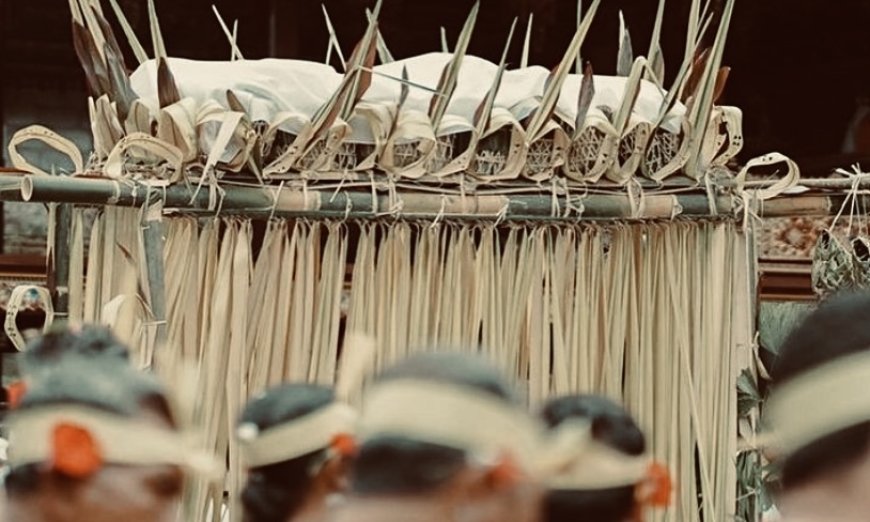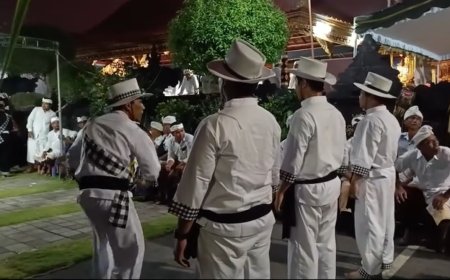Mejarag: Representation of Gratitude and Pest Repellent in the Agrarian Society of Sebatu Traditional Village
Bali is a special place with a diversity of tribes and traditions that are still firmly adhered to by the people. One of them is the Mejarag tradition which depicts an expression of gratitude to Sang Hyang Widhi Wasa. Tradition is indeed one of the attractions of this island. Apart from its many tourist attractions, Indonesia, which has many tribes and cultural diversity, also makes traditions in Bali an attraction for foreign tourists, but also attracts Indonesian tourists.

Fighting over (Mejarag) ceremonial facilities containing subak krama agricultural products (Photo Source: Editorial Collection)
Mejarag is a tradition that exists in Banjar Sebatu, Tegallalang, Gianyar, Bali. This tradition is also often called Karya Nuuh which is held once a year in the Pura Desa and Pura Puseh areas of Pakraman Sebatu Village, during the two rice harvest seasons. The benchmark for holding the Nuuh or Mejarag ritual tradition is Tri Wara (Pasah, Beteng, Kajeng).
As mentioned Prajuru Banjar Sebatu, Tegallalang, the Mejarag tradition, among others, is a ceremonial facility containing agricultural products presented by krama subak. After finishing praying at the Main Mandala Temple, the Nuuh or Mejarag ritual will be carried out.
Before this tradition was held, the people of Sebatu Banjar offered offerings in the form of offerings in the form of offerings placed on trays (sok kepe) containing their typical snacks such as: plate snacks, crorot snacks, buntilan snacks and layered snacks. Not only snacks, but also filled with various kinds of fruit, then the offerings are served at the Banjar Sebatu village puree
Before this tradition was implemented, the people of Banjar Sebatu offered offerings in the form of offerings placed on trays (sok kepe) containing their typical snacks such as: plate snacks, crorot snacks, buntilan snacks and also layer snacks. Not only is it a snack but it is also filled with various kinds of fruit, then the offering is brought to the village of Banjar Sebatu to be offered (Suun is the term for carrying an offering placed on one's head to be offered). Then the whole community nangkil (sat) and watched the ritual, at which time a man was embraced in the ceremony by Jro Mangku, he was the one chosen to be The adur craftsman who would later become the keeper of the offerings that would be jarag (confiscated). The adur craftsmen (keepers of the rules called banten) follow the words of Jro Mangku who is reciting the mantra from the lontar, after the entire congregation has finished praying.

Chanting the mantra from Jro Mangku followed by Adur (Photo Source: Editor's Collection)
Not just anyone can become a The adur because only parents (husbands) who have sons and daughters can become The adur. After the prayer, the whole community rushed to Nista Mandala Pura to witness the Mejarag Tradition, the kulkul was beaten and all the children who followed the tradition were not wearing clothes and they shouted loudly "Suryakin Ooeee, Suryakin Ooeee, Suryakin Ooeee, only those who are allowed to follow the tradition for men only. Not only that, when a man has had his teeth cut ceremony (mesangih) then he is not allowed to follow the Jarag tradition. wants to eat everything that grows in the fields, especially rice.

Children participating in the mejarag activity (Photo Source: Editorial Collection)
After that, the community waits for the person who is offering the offerings (bringing the offerings placed on their shoulders) with great wisdom. The offerings were made by four people, then after that The Adur craftsmen came out to Jabe Temple or called Nista Mandala Pura (derived from the temple) carrying three sticks tied with Tridatu's stick ropes which would be used to nigtig (beat) the children who were going to rag. , then when the offerings to be contested are in the designated Nista Mandala area, the children will run, jump and scramble to get the offerings, then The Adur hits the children with a stick until they turn red. or bleeding, and even then, without realizing it, The Adur hit the children for reciting the mantra of lontar with great emotion which was recited by Jro Mangku. There are so many questions about "Why do the children take the offerings, then The adur beats the children who take the offerings?" because basically this tradition tells the story of a farmer (The Adur) who looks after his rice fields, then his rice is eaten by pests (children) so the farmer drives away the pests by nigtig (hitting) the pests.

Offerings are brought to Nista Mandala (Photo Source: Editorial Collection)
After the confiscation of the ceremonial equipment was complete, the remaining ceremonial equipment was taken to the west of the temple. Then the ingredients in the form of rice, rice and leftover meat are put into the krama subak (requested) to be thrown into the paddy fields in their respective fields, so that they grow well. Meanwhile, the remains of sticks that were previously used to nigtig (beat) children were also scattered or given krama subak to be stuck at each end of the rice field. This is considered an abstract antidote to pests (nangluk merana). And continued with offering offerings (bringing offerings to the Main Mandala temple). The meaning of the Mejarag Tradition is an expression of gratitude for all the gifts in the form of fertility and abundant results from agricultural products that have been given by Ida Sang Hyang Widhi Wasa, as well as asking for safety and protection.






























































